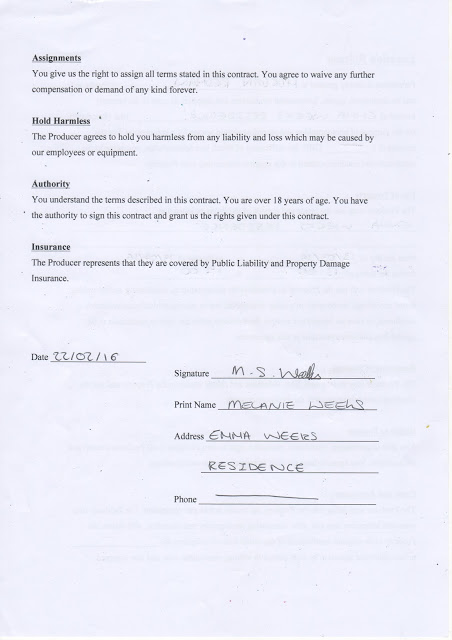Friday, 29 April 2016
Tuesday, 26 April 2016
Main Task Synopsis -
Synopsis of 'The Three' -
Synopsis: A brief summary about a film within a few paragraphs that does not give away more than one plot event.
A murderer with an obsessive compulsion and precise selection process plans the ultimate murder for their third and final victim to form the final part of their 'collection' with the investigation team hot on their tail.
Synopsis: A brief summary about a film within a few paragraphs that does not give away more than one plot event.
A murderer with an obsessive compulsion and precise selection process plans the ultimate murder for their third and final victim to form the final part of their 'collection' with the investigation team hot on their tail.
Main Task Make-up Media Testing and Final: Risk Assessment
Prosthetic Make-up Test -
Equipment -
This was the first attempt of prosthetic make-up using the exact product; the product itself was Artex two part silicon solution. The solution built up and solidified on the skin surrounding the desired area which was therefore problematic as it crinkled the skin.
This was the second attempt which was much better than the first. The skin surrounding the cut was smoother and looked less like prosthetic make-up, however, the cut was less deep than expected so this will be corrected in the final filming.
Summary -
The most significant element of make-up for this shoot is the prosthetic scars. The individual scar is a roman numeral symbolising the number one. Each victim's arm will be scarred to depict the title 'The Three'.
Equipment -
- Artex Silicone Gel
- Kryolan Death Palette
- Kryolan Cuts and Bruises Palette
- Fake Blood
- Powder (to set the Artex)
- A cosmetic spatula
- A small tool to create the cuts (for example a metal cuticle stick)
- A powder brush
- A small makeup brush
Instructions -
1. Clean wrist with solution to create a seal against the Artex.
2. Mix together part A and part B being careful not to contaminate either pot of gel as this will cause the solution to prove before it can be used again.
3. Apply mixed solution to wrist in a vertical line along the veins (keeping the majority of the Artex mixture in the centre of the wrist is vital at this point.
4. Begin to blend the Artexmixture out away from the wrists centre to create a smoother and more realistic texture using the cosmetic spatula.
5. Create a cut in the Artex mixture using the small tool this will become the base of the cut.
6. Leave the Artex mixture to sit for two minutes then dust with powder to help the mixture set.
7. Using a small brush draw a line of bright red down the centre of the cut slightly past the edge of the cut to create a more realistic effect.
8. Add a darker tone of red to make the cut appear deeper.
Media Planning Documents -
Documents -
Camera Shot List:

Camera Shot List:

Location Release and Contract:
Personal Releases:
Talent Releases:
Production Budgeting Proposal:
Risk Assessment:
Edit Log:
Call Sheet:
Secondary Research -
Audience -
G: Gender
E: Ethnicity
A: Age
R: Region/Naionality
S: Socio-Economic Group
Gender: All genders due to female lead and orientated plot and characters. Horror/ thrillers are stereotypically masculine even with female leads such as Carrie but ours is aimed at all.
Ethnicity: Any ethnicity as long as they can engage in english language due to the language barrier.
Age: 18 and over due to the nature of the BBFC rating system although younger audiences of teenagers may engage with this media.
Region/ Nationality: Cast is caucasian and european and therefore is stereotypically aimed towards this audience. Lack of other ethnicities is unintentional due to who was available at the time.
Socio-Economic: C1 bracket down to the the E bracket in the traditional segmentation model due to E being where students fit into the system.
Theorists -
Hypodermic Syringe Model:
- Passive audience
- Addicted to media
- Rely on daily dosages
- Believe and accept everything presented to them
- Media is more powerful than audience
- (Also called 'Magic Bullet')
Uses and Gratification Approach:
- Active audience
- Use media to appease their wants and needs
- More powerful audiences than media
- Identity
- Information
- Interaction
- Entertainment
- Active audience
- Decode their own meaning from media, despite producers context
- Audiences equal with media
Young and Rubican 4 C's:
- Four main categories: (MARS) Mainstreamers, Aspirers, Reformers and Succeeders.
- Other three (ERS): Explorers, Resigned and Struggler
Friday, 22 April 2016
Subscribe to:
Comments (Atom)





































